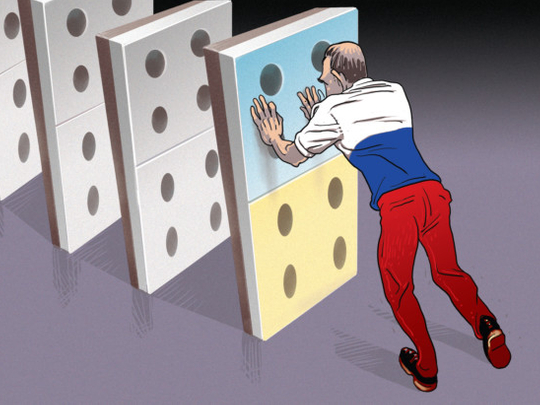
This month’s Nato summit in Wales responded to Russia’s actions in Ukraine with a new commitment to a rapid-reaction force and forward deployments in Poland and the Baltics. The message was delivered that Nato is here to stay and is unified in opposition to Russia’s aggression. But what tangible form will this opposition take now that Russian President Vladimir Putin has moved his line of control westward beyond the Donetsk region of eastern Ukraine?
Putin began his conquest by walking into Crimea. He then installed the “insurgents” in and around Donetsk who shot down Malaysia Airlines Flight 17. When they began losing, he invaded. He is following the winning strategy used in Transnistria (taken from Moldova) and South Ossetia and Abkhazia (taken from Georgia). His actions are supported by a population at home that is pleased with Russia’s oil money and given little access to news not generated by the state’s propaganda machine. His ultimate objective is to convert as many of the former Soviet republics into “satellites” as he can.
It is foolish to believe that the current “ceasefire” will become a true settlement of this war. There is already evidence that Russian forces have violated it by shelling the outskirts of Mariupol, the important port near the eastern end of Ukraine’s Black Sea coast. Ukrainian President Petro Poroshenko travelled to Mariupol on Monday to declare that Ukraine would never yield the territory to Russian-backed insurgents. Ukrainians are well aware of the huge danger of failing to defend this city.
But the danger goes far beyond Mariupol. Putin claims a right to “Novorossiya,” an 18th-century Russian conquest that encompassed all of Ukraine’s Black Sea coast. He says his concern for this area is to protect Russian-speaking people; it seems clear that what he really wants is a land bridge to Crimea and Transnistria. Without this connection, Russia must support these conquests by air and sea. With them, he avoids a huge cost while leaving behind a rump Ukraine more likely to accede to satellite status. Western leaders, including President Barack Obama, have emphasised that there is no military solution to this crisis. Clearly, the direct use of Nato or US forces to fight Russia is not an option. But that does not mean no military steps can be taken. We must begin by accepting that Russian control of the Donetsk region is a fait accompli. The Ukrainian army is in retreat, and in a retreat, the goal is not to escape; it is to fall back to a new, more defensible line. This line should begin at Mariupol and extend toward Kiev, isolating the Donetsk region and keeping open the possibility of an eventual return of Ukraine’s territory.
Special forces
The Ukrainian military is capable of defending this line if it is given adequate Nato support, led by the US. Five packages are needed:
n As was done in Iraq when it appeared that the Islamic State of Iraq and the Levant (Isil) might take Baghdad, several hundred advisers, special forces and security assistance specialists should be deployed immediately to assess the situation and begin to build the necessary working relationships with the Ukrainian army.
n Nato supplies, ammunition and weapons systems should be shipped to Ukraine; most of what is needed can come from European nations.
n Intelligence and command-and-control support should be provided, including Nato surveillance planes.
n Air defences should be improved, including patrols by Nato Airborne Warning and Control System (Awacs) aircraft.
n Intensive training and operational assistance should be provided to create a solid defensive line.
Once an announcement of this plan is made, especially if it coincides with strengthening of the sanctions regime, Russia will respond with inflammatory rhetoric, mostly based on falsehoods and threats. This must be ignored. What is needed is deterrence. Russia must be convinced that Nato and the US will do whatever is necessary to support a Ukrainian fight against further Russian invasion.
Obama has just announced his new strategy to deal with Isil. It will be difficult for him to embark on another, somewhat similar mission only days later. But we have little time to assist Ukraine to establish a defensive line that can stop Putin before his conquests force us into a long, mini-Cold-War struggle. If this new defensive line is not established and held, it is likely that Ukraine will again lose its independence. At a minimum, Crimea will be tightly controlled by Russia for decades or longer. And while “domino” theories are to be avoided, the rest of former Soviet Central Asia would be more likely to face Russian intimidation and military power.
Russia’s petroleum revenue cannot sustain such aggression forever. But for now, we must tangibly support Ukraine or our confrontation with Russia could intensify until we are once again relying only on nuclear deterrence to avoid catastrophe. Notwithstanding US war-weariness and the many demands on its budget and military, it is very much in its national interest to avoid this outcome.
—Washington Post
Jan Lodal is a distinguished fellow at the Atlantic Council.









